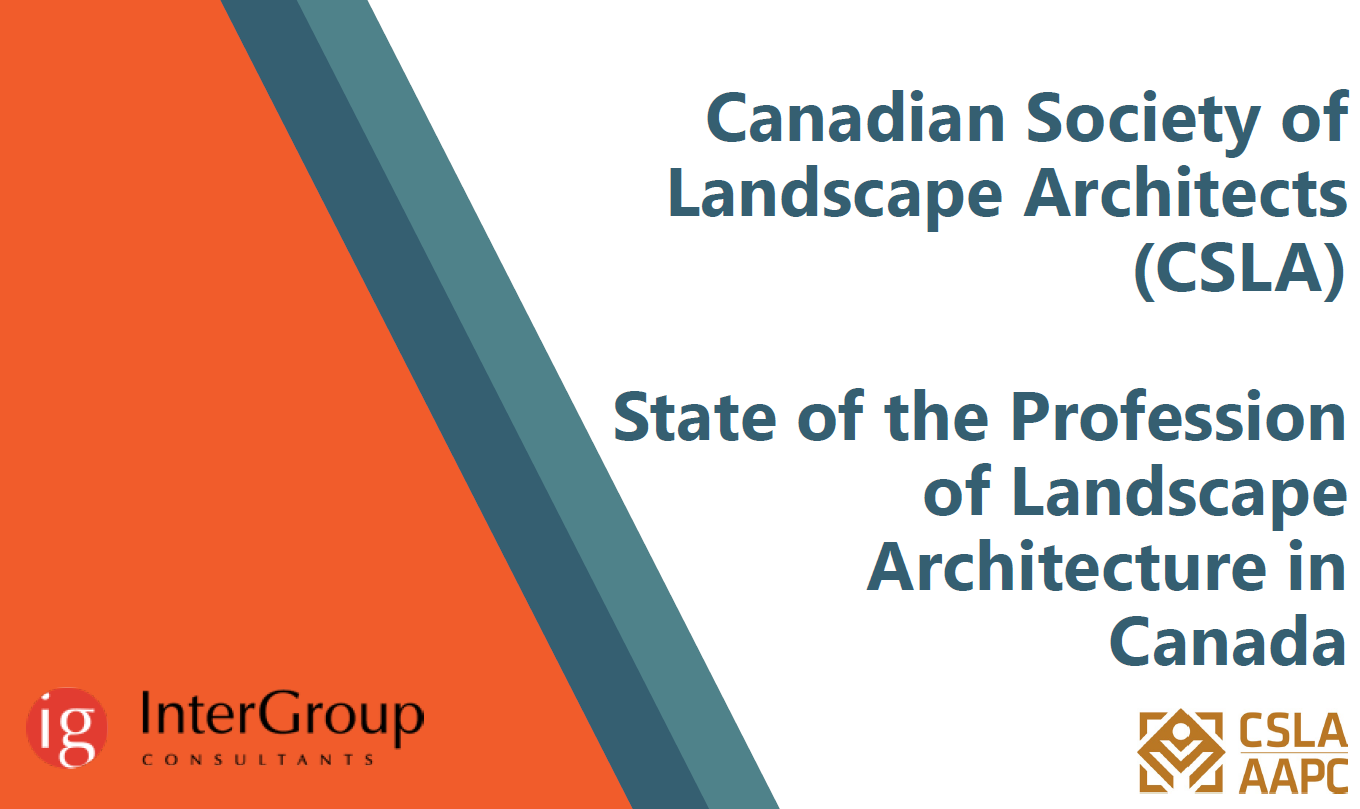 CSLA Releases a Report on the State of the Profession of Landscape Architecture by Winnipeg-Based Firm InterGroup Consultants
CSLA Releases a Report on the State of the Profession of Landscape Architecture by Winnipeg-Based Firm InterGroup Consultants
Report Presents Data to Inform Advocacy, Support and Quantify the Profession's Impact on Canadian Society
The CSLA Board of Directors wishes to thank the report working group: Carolyn Woodland, Michael Magnan, Joanne Moran and Michelle Legault.
- Full report: which contains Employment and Income Demographics, Business Performance, Economic, Social and Environmental Impacts and Education and Training
- Appendix A: Quantitative Research: which summarizes the findings of the quantitative research, such as indicators analyzing landscape architecture employment and labour force characteristics, demographic variables of workers classified as landscape architects, business performance for firms and the number of accredited landscape architecture program graduates.
- Appendix B: Membership Survey: information on the demographics, employment status, and professional practice of CSLA members.
- Appendix C: Stakeholder Interviews: which were undertaken to collect information to supplement, confirm, and gain additional insight.
- Appendix D: Case Studies: which demonstrate the profession's positive impacts on the economy, the environment and the community.
Study Highlights
A) Landscape architecture is a growing profession
- Since 2011 employment in landscape architecture has grown by an estimated 400 workers. The majority of this growth has been in full-time positions. Employment income grew at a faster rate for landscape architects (33%) than other occupations in the natural and applied sciences (18%) and the rate for all occupations (16%) between 2011 and 2021.
- Graduates from university-level programs has also increased, from 131 in 2014/15 to 161 in 2018/19.
B) Strong current and projected future employment demand
- In 2021 landscape architects had a very low unemployment rate (1.4%). Interview and survey participants were optimistic about future employment prospects in the industry. Forecasts prepared by the Canadian Occupational Projection System indicate retirements are anticipated to generate a number of job openings over the next ten years. Interview participants commented that strong labour demand is expected to put upward pressure on salaries over the next several years.
- Progress has been made on diversity and inclusion but more work remains
- Landscape architecture is a gender balanced profession, with a roughly equal number of men and women. The income gap between men and woman has narrowed over the last ten years. Some interview respondents noted the profession would benefit from increased representation of women in senior positions.
- The proportion of people who identify as visible minorities in the profession increased from 10% in 2016 to 14% in 2021. This still trails the proportion in other natural and applied science occupations and the total population. About 1% of landscape architects identified as Indigenous in 2016 compared to 4% of the population of Canada.
- Interview participants noted a number of efforts to recruit and support people from diverse backgrounds to the profession but acknowledged continued efforts are required.
C) Business revenues and profits have increased
- Operating revenues for landscape architecture firms increased from $380 million in 2013 to $746 million in 2021. Operating profits increased over the same period from $51 million to $147 million.
- Housing and infrastructure spending are key drivers of new business. Interview participants commented that investments in housing and public infrastructure are key sources of work. Urban development and intensification projects have become more prominent. As an example, the number of apartment unit housing starts increased from 96,000 in 2012 to 148,000 in 2022 (54% increase). Public and private sector infrastructure spending has also been increasing, from a total of $72 billion in 2012 to $112 billion in 2022.
D) Landscape architecture improves community health and well-being
- Well-designed public spaces create opportunities for social interaction and physical activity leading to better physical and mental health for people and communities.
- Public gathering places promote interconnectedness and can reduce feelings of social isolation.
- Landscape architecture helps drive climate change adaptation and protects ecological system functions
- Interviews and case studies highlighted the ways landscape architecture helps communities respond to a changing climate. From protecting and enhancing natural environments to improving flood protection and storm water management, landscape architects are at the forefront of climate change adaptation.
E) Landscape architecture helps revitalize cities
- Interview and survey respondents provided many examples of how their work helps drive urban renewal. Memorable, functional public spaces become key attractions for both local residents and visitors and catalysts for larger community investment and public realm revitalization.
F) Reconciliation with Indigenous peoples is a key focus for landscape architects
- Understanding Indigenous history and incorporation of Indigenous perspectives into landscape design is a key principle in the practice. During interviews, landscape architects talked about how they incorporate principles of reconciliation into their work.
Related Information
CLARB's Global Job Task Analysis for the International Federation of Landscape Architects (IFLA) (2023): In an effort to develop a global definition and description of the practice of landscape architecture, the International Federation of Landscape Architects (IFLA) and the Council of Landscape Architectural Registration Boards (CLARB) partnered to conduct a Global Job Task Analysis. Goals included:
- better understand the profession of landscape architecture across the globe from the perspective of practitioners
- identify how practice is similar or different globally, regionally and nationally
- broaden the scope of the landscape architecture profession, where possible
A job task analysis (JTA) is a systematic procedure for analyzing the tasks performed by individuals in an occupation, as well as the knowledge, skills, and abilities required to perform those tasks.